The word Wurundjeri is the combination of the Woiwurrung words ‘wurun’ meaning the Manna Gum (Eucalyptus viminalis) and ‘djeri‘, the grub which is found in or near the tree. Wurundjeri are known as the ‘Manna Gum people’.
Before invasion, there were multiple Woiwurrung speaking clans who neighboured each other. Today, those people who descend from the Wurundjeri willam clan of the Woiwurrung language group, refer to themselves as Wurundjeri Woiwurrung.
Due to our connection to the land around the Birrarung (Yarra River) and the river itself we are sometimes historically referred to as the Yarra Yarra Tribe.
Clans
Each of these clans was governed by an individual or group of senior men who had the title Ngurungaeta. These individuals were men of distinguished achievement who had effective authority within their clans and 'were considered its rightful representative in external affairs'
Wurundjeri-Balluk
The Wurundjeri-Balluk clan consisted of two patrilines (families descended from a male ancestor), each occupying the adjacent areas on both sides of the Yarra River.
Wurundjeri-willam
One of these patrilines was the Wurundjeri-willam clan who were divided amongst three locations.
The first was on the southern side of the Yarra River, from Gardiners Creek to the northern slopes of the Dandenong Ranges.
The second area was on the northern side of the river, from its junction with the Maribyrnong River (and stretching north to take in Mount William), at Melbourne, and east as far as Kew;
The final area was from around Heidelberg, along the upper reaches of the Yarra to near Mount Baw Baw.
Buluk-willam
The second of the two patrilines was the Buluk-willam clan who occupied an area from the headwaters of the Yarra River, southeast to Koo Wee Rup Swamp, toward Cranbourne, where they bordered Boonwurrung territory, at the top of Western-port Bay.
Marin-Balluk
The Marin-Balluk clan identified with the area between the Maribyrnong River and Kororoit Creek, stretching to the north as far as Sunbury.
Gunung-willam-bulluk
The Gunung-willam-bulluk clan identified with an area south of the Ranges, around Mount Macedon and Bacchus Marsh.
Kurung-jang-balluk
The Kurung-jang-balluk clan identified with the western side of Kororoit Creek, as far as the Werribee River.
Each of these clans was governed by an individual or group of senior men who had the title Ngurungaeta. These individuals were men of distinguished achievement who had effective authority within their clans and 'were considered its rightful representative in external affairs'.

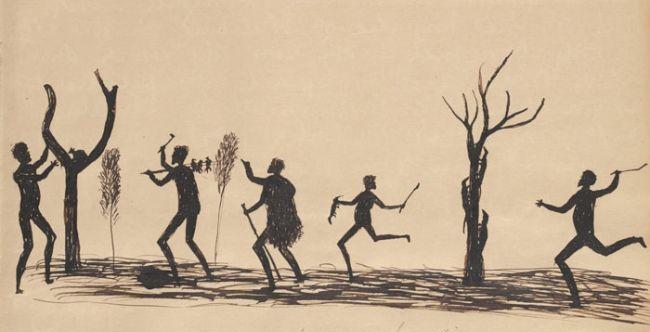
Tommy McRae : Out Hunting For Dinner – A Run Of Luck : Courtesy of the State Library of Victoria Picture Collection
Farming and Agriculture
Prior to colonisation, Our people were self-sufficient; we gathered all we needed to eat and live from the land around us. This meant we needed to know our land and the plants and animals intimately, and learn how to track, hunt, fish, and find the bush foods when they were in season. We would never take more than the land could spare, because we knew that the health of the land and our own health were tied together.
Different foods were available at different times of the year, and we moved to where the food was most plentiful. At Yarra Glen, hundreds of birds gather in the Breeding Season, and we would feast off them – as well as finding swan and duck eggs. At Bulleen in the Autumn, eels are on their way to migrate down into Port Phillip Bay and out to the ocean to breed. We could easily capture the eels in our eel traps.
Our people would also burn off the land regularly, so that plants would grow back lush and attract animals.
Men would hunt the bigger animals such as kangaroos, wallabies, echidnas, possum, emu, wild duck, goannas, using spears and spearthrowers (garrik), clubs and boomerangs (wonguims). The women would hunt smaller animals, such as fish, shellfish, and lizards. They also collected fruit, nuts, berries, leaves and tubers.
We cooked most of our food in earth ovens. A hole would be dug, lined with stones, and a fire lit inside. When the stones were very hot, we pulled the fire and stones out of the hole and lined it with multiple layers of moist leaves and hot pebbles The food we wanted to cook is put in next, covered with another layer of leaves and hot stones, and the whole oven is covered with earth until the food was cooked.
Earth Ovens - Celebrating Aboriginal Intangible Heritage

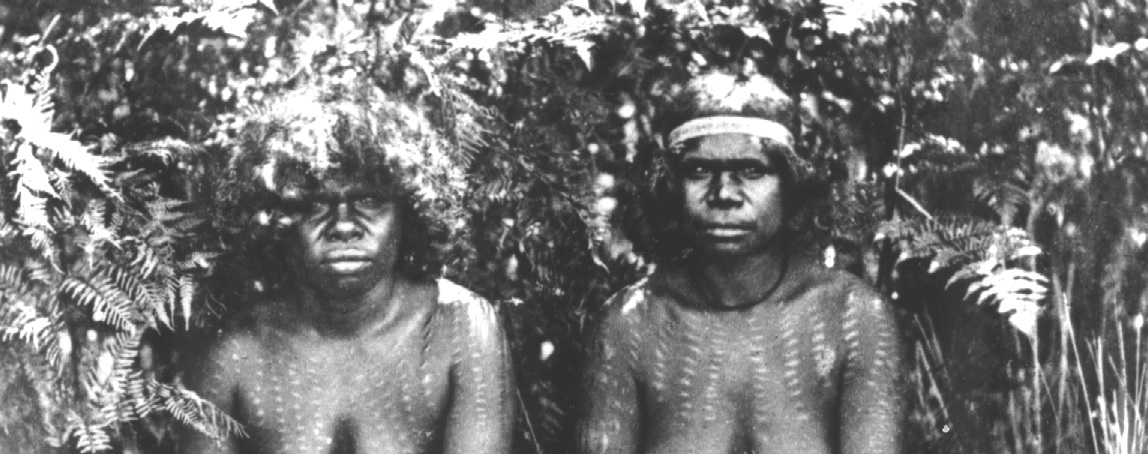
Wurundjeri women, Melbourne. c. 1858-1859 (Detail). Acquired Museum Mankind, photograph A.J. Fauchery. Courtesy Museum Victoria
Roles & Responsibilities
Men
Men’s responsibilities began when they were about fourteen years old. An uncle from their mothers’ clan would take the boy, and he would stay with him for many months of training. He would put the boys through tests, which they had to endure with courage to prove their worthiness for manhood and the uncle would teach them sacred men’s knowledge. This was their initiation into the world of men. When the training is complete and the young boy was initiated there was a great celebration where neighbouring clans were invited to join in.
Our men’s day-to-day duties were to care for their families and clan. They hunted game and fish, defended our people from enemies, and avenged any wrongs done to us by other groups.
A man carried only what he needs as he goes through the bush, following the trail of a kangaroo or emu. He carried his spear and spear thrower, or garrik, and his boomerang. Each man also carried his precious stone axe. The stone is ground to a sharp edge and fixed to the handle with sinews and gum. As our men became skilled in the ways of the clan, they usually became particularly good at one art or another and would gain respect from the people.
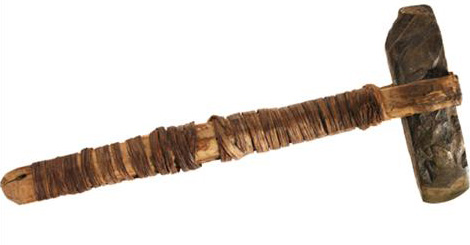
Museum Victoria - Greenstone axe used by William Barak at Coranderrk between 1884 and 1906.
Women
Our women were very important to the whole clan. They cared for and raised the children; they gathered food and medicinal plants and prepared our meals.
Girls started to learn secret knowledge at their mothers’ and aunties’ sides from a young age and continued to learn from them as they prepared for the responsibilities of adulthood. When Wurundjeri girls would marry, they went to live with their husband’s clan. The women of that clan taught them about the plants and animals of the region where they lived and continued to pass on important wisdom. If they had lived well and had taken care of their families and gathered the wisdom of the people, when they were old the women would be respected Elders of the clan.
Women would often carry a digging stick (konnung or kannan) to dig roots from the ground – it also doubled as a weapon to protect themselves and their children if necessary.
The women also carried a coolamon, a wooden carrying dish, for seeds and berries. If the clan was travelling to a new campsite, they were the ones who carried our baskets and cloaks and other precious belongings.
Wurundjeri women were experts at making beautiful baskets, necklaces and bracelets, and the warm cloaks we wore, from animal skins stitched together with sinew. They would also spin the string for nets, like those we used for duck hunting. And at our festivals, the women would stretch cloaks over their knees and drum the rhythm for our singing.
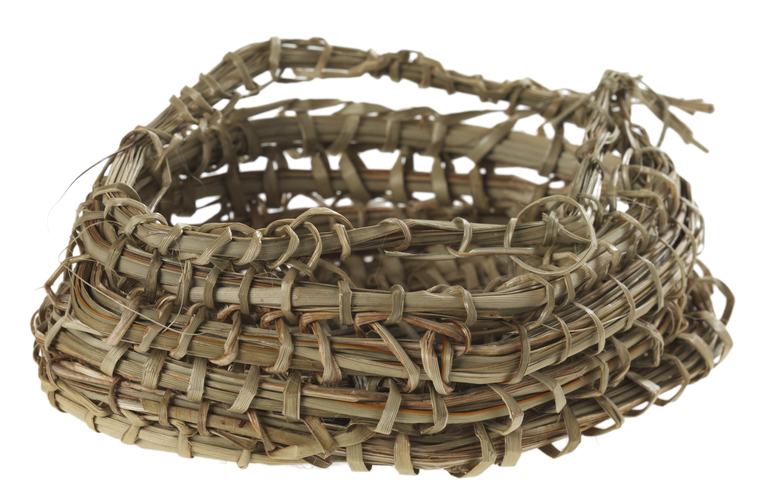
Museums Victoria Collection - Basket, Binak, Wurundjeri, Victoria, Australia
Children
As children, we would spend our days with our mothers and aunties on their food-gathering outings. We could play outside as we like, climbing and swimming and running about.
Our children were always learning things that were important to know when they become adults. They learnt about the plants and animals by watching their mothers and aunties gather bush food. They also helped by catching birds and gathering useful materials like gum. When we arrived at a new campsite, they watched the women make fires and gather water and when the men arrived, they watch them set up their willams, and they listened to the stories about the day’s hunting.
The games we played as children were often ‘practicing’ for things we would do when we were older. Boys made toy spears and boomerangs, and girls played ‘cat’s cradles,’ with patterns of string between their fingers. And of course the older children always had younger ones and babies to help nurse and entertain.
Boys and men often played a ball game called marngrook (this is the game that inspired AFL). The ball is round and is made of possum skins tied up very tightly with kangaroo sinews. The players divide into two teams, and the game is played by dropping the ball and kicking it high with the instep of the foot. Whoever gets it kicks it again. The side that kicks it most often and kicks it the furthest wins the game!
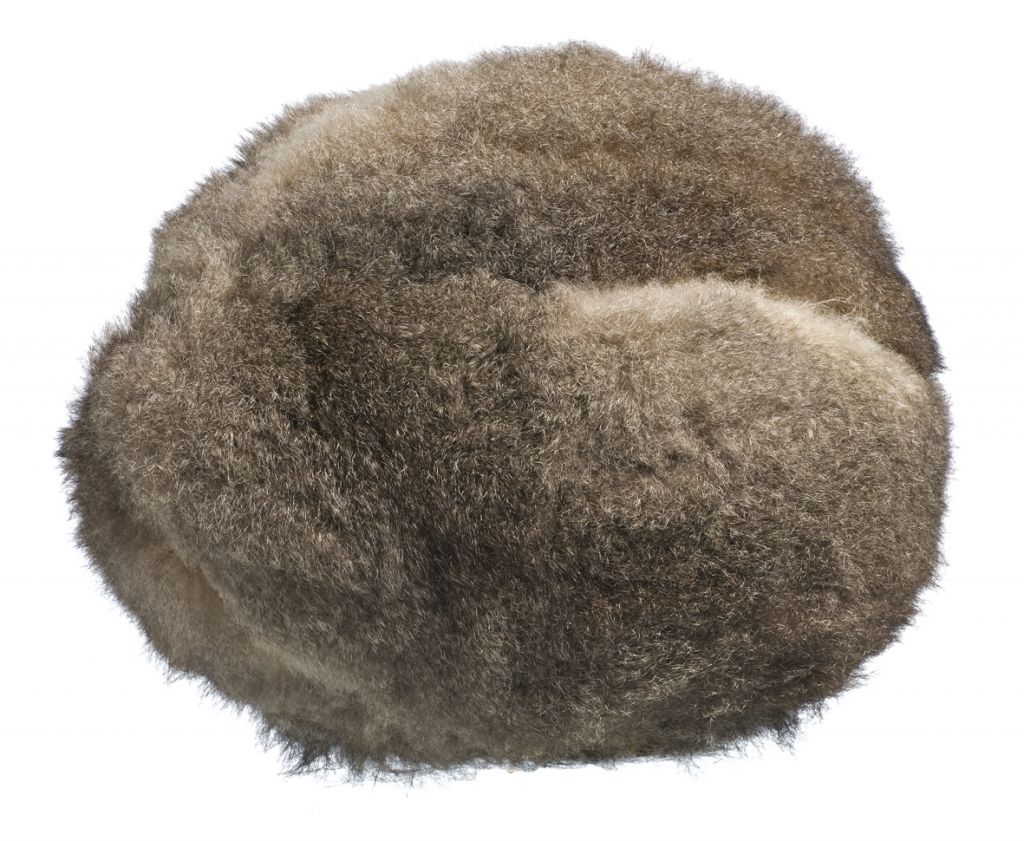
The Koorie Heritage Trust - Marngrook
Elders
Those who gained particular respect and were seen as leaders became the clan’s Elders and made decisions on behalf of their people. If a man was very wise, spoke the truth always and did no wrong, he may have become the clan’s Ngurungaeta, the most respected and influential Elder of the group.

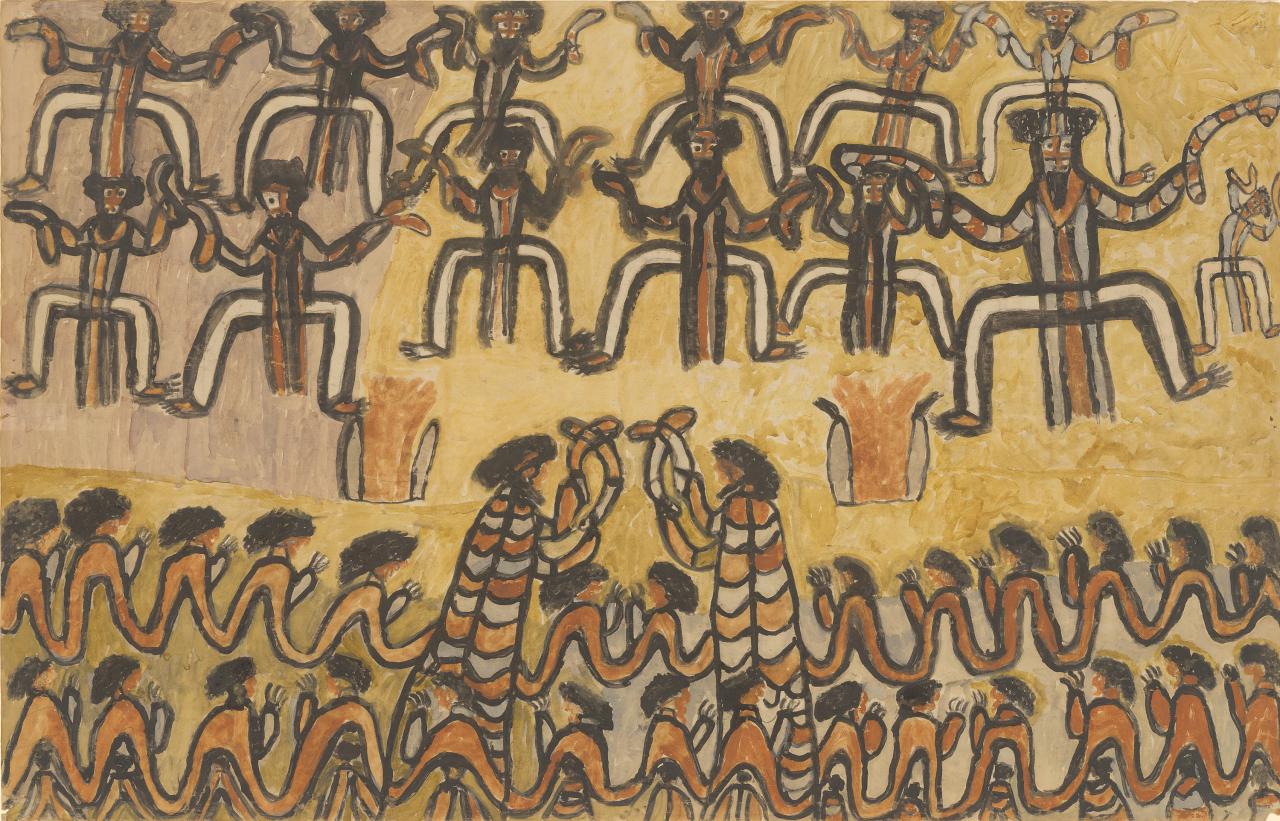
'Ceremony' (1898) William Barak. NGV Online Collection
What We Wear
The women used red ochre to colour their faces. The men sometimes wore a thin bone through the septum of their noses. All of us enjoyed wearing feathers in our hair, and bracelets on our wrists and ankles, and sometimes we wore emu feather skirts. The women made beautiful necklaces from seeds and segments of dried reed, kangaroo teeth or echidna spines, carefully threaded together.
In the cold weather, we wore long cloaks made from kangaroo or possum skins. It takes about forty possum skins, carefully prepared, to make one cloak and many of our Elders and Leaders still wear them when conducting cultural business today. The women would sew them together very neatly, using sinews from a kangaroo’s tail. We also used these cloaks as blankets on cold nights. They were sometimes used as drums as well. When big ceremonies and festivals came along, we spent hours painting intricate and beautiful patterns on our bodies. Different clans had different patterns and symbols. We use red ochre, brown ochre, white pipeclay and black charcoal, which we either found on our own land or traded in from distant clans.
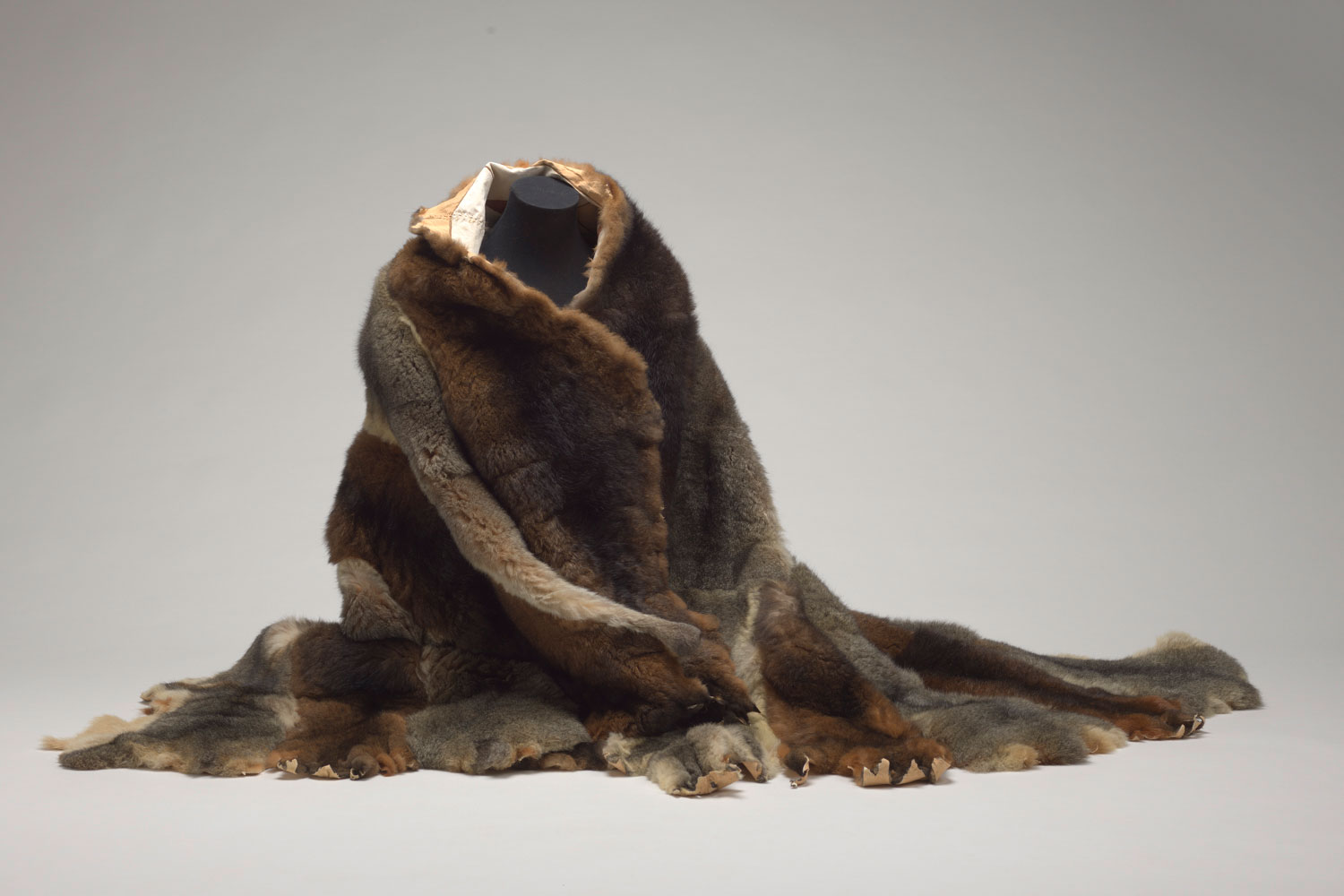
AIATISI - A Possum Skin Cloak
Ceremony and Gatherings
The Tanderrum Ceremony is our way of offering welcome to a group of visitors to our land. They will come into the place that we have prepared, carrying bark fire in their hands – the women and children from one direction and the men from another. Some members of a clan who are friendly both to our own clan and to the newcomers’ clan will introduce the Elders. We then take boughs from many different trees, to show that our new friends are welcome to everything our land offers, and build seats of honour for them. We build two fires, one for the men and one for the women and children, and for the first day we take care of all their needs. We build their willams, and bring them drinks and as much food as our land offers in the season so they know that they are truly welcome among us.
Once a year or so, we have a great gathering with many of our Kulin allies. Disputes are settled by ceremonial fighting, and once the fight is over, those clans will be friends again. The Elders discuss possible marriages, and the young men give gifts to the parents of the girl they are hope to marry. There are many days of games, like running and wrestling and marn-grook. We catch up with all the news and we spend hours painting and preparing for our dances and songs that we show off to the other mobs. This great gathering is a very important way of strengthening the ties of friendship between all the Kulin peoples.
Tanderrum - Melbourne International Arts Festival
After Colonisation
Wurundjeri people were resilient, and thanks to our ancestors never giving up the fight we were able to survive invasion and colonisation.
Most of the surviving Wurundjeri people were moved to Coranderrk station along with others from the Kulin Nation. Coranderrk Aboriginal Station is located on the Yarra Flats, bordered by the Yarra River, Badger creek, Watts River and the slopes of Mount Riddle. It quickly grew to become Victoria’s biggest reserve with 105 residents. Due to the leadership of Uncle Wonga, Uncle Barak, John Green (the Station manager) and others at Coranderrk, the reserve became a thriving farming community that was able to operate independent of government. You can learn more about Coranderrk Aboriginal Station here!
In more modern times our community leaders and Elders have been working hard to bring back our traditions and ceremonies to for us to take part in.
In 2013 the first Tanderrum ceremony was held in Federation Square with the other members of the Kulin Nation for the first time in many, many years. The Woiwurrung language is also being revived and revitalised and is being taught is some schools alongside our culture.
Sources
- Victorian Aboriginal Corporation for Languages, Woiwurrung
- Nillumbik Reconciliation Group Inc, Wurundjeri Culture Resource Kit.
